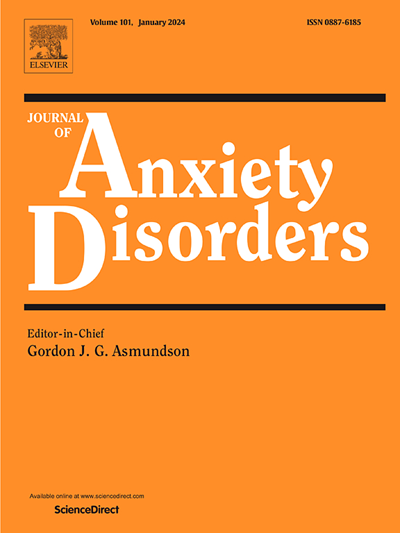社交焦虑的安全行为消退:自我监控干预的随机对照试验
IF 4.5
2区 医学
Q1 PSYCHIATRY
引用次数: 0
摘要
安全行为(SBs)被假设在社交焦虑中发挥关键作用,并作为社会心理治疗的可行目标。虽然减少SB是社交焦虑的一些认知行为疗法的一个组成部分,但之前的研究表明,安全行为消退也代表了一种可行的、独立的社交焦虑数字治疗方法。本研究的目的是在可信的对照条件下,对报告社交焦虑症状升高的个体进行为期一个月的自我监测SB治疗。参与者(N = 201)被随机分为两组,一组是SB消退组(N = 99),另一组是不健康行为消退组(N = 102)。与对照组相比,脑缺血消退导致术后脑缺血使用减少,但1个月随访时无此影响。与预测相反,在治疗后和随访中,两种情况下的社交焦虑和相关结果(抑郁、孤独)都有显著和可比的减少。治疗可信度和期望调节了条件的影响,因此在对治疗有更积极信念的参与者中(在提供基本原理后),SB条件下的参与者报告的随访社交焦虑显著低于对照组。此外,在SB条件下,基线时较高的社交互动频率和较低的孤独感预示着随访时较低的社交焦虑。总的来说,我们的研究结果表明SB消退作为单独干预的局限性,并表明这种策略对那些与他人互动更频繁和对这种治疗方法更有信心的人更有效。我们讨论了临床意义和未来的研究方向,包括对SB治疗方案的潜在改进。本文章由计算机程序翻译,如有差异,请以英文原文为准。
Safety behavior fading for social anxiety: A randomized controlled trial of a self-monitoring intervention
Safety behaviors (SBs) are hypothesized to play a key role in social anxiety and present as a viable target of psychosocial treatments. While SB reduction is a component of some cognitive-behavioral therapies for social anxiety, prior research suggests safety behavior fading also represents a viable, standalone digital treatment for social anxiety. The aim of the present study was to test a one-month self-monitoring SB treatment in individuals reporting elevated social anxiety symptoms against a credible control condition. Participants (N = 201) were randomized to either a SB fading condition (n = 99) or an unhealthy behavior fading control (n = 102). Compared to control, SB fading led to lower SB use at post but not one-month follow-up. Contrary to predictions, both conditions saw significant and comparable reductions in social anxiety and related outcomes (depression, loneliness) at posttreatment and follow-up. Treatment credibility and expectancy moderated the effect of condition, such that among participants with more positive beliefs about treatment (after being provided with the rationale), those in the SB condition reported significantly lower follow-up social anxiety than those in control. Further, in the SB condition, both higher social interaction frequency and lower loneliness at baseline were predictive of lower social anxiety at follow-up. Overall, our findings show limitations to SB fading as a standalone intervention and suggest this strategy is more effective among those who interact with others more frequently and who are more confident in this treatment approach. We discuss clinical implications and future research directions, including potential refinements to SB treatment protocols.
求助全文
通过发布文献求助,成功后即可免费获取论文全文。
去求助
来源期刊

Journal of Anxiety Disorders
Multiple-
CiteScore
16.60
自引率
2.90%
发文量
95
期刊介绍:
The Journal of Anxiety Disorders is an interdisciplinary journal that publishes research papers on all aspects of anxiety disorders for individuals of all age groups, including children, adolescents, adults, and the elderly. Manuscripts that focus on disorders previously classified as anxiety disorders such as obsessive-compulsive disorder and posttraumatic stress disorder, as well as the new category of illness anxiety disorder, are also within the scope of the journal. The research areas of focus include traditional, behavioral, cognitive, and biological assessment; diagnosis and classification; psychosocial and psychopharmacological treatment; genetics; epidemiology; and prevention. The journal welcomes theoretical and review articles that significantly contribute to current knowledge in the field. It is abstracted and indexed in various databases such as Elsevier, BIOBASE, PubMed/Medline, PsycINFO, BIOSIS Citation Index, BRS Data, Current Contents - Social & Behavioral Sciences, Pascal Francis, Scopus, and Google Scholar.
 求助内容:
求助内容: 应助结果提醒方式:
应助结果提醒方式:


